
Rock Springs, 1904
The large square building is the high school. See next photo. ,p>
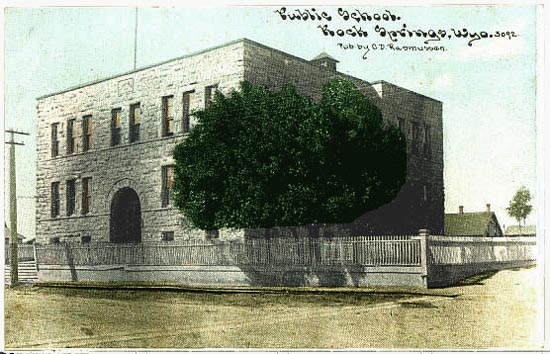
Rock Springs High School, undated. Postcard published by
O. D. Rasmussen.
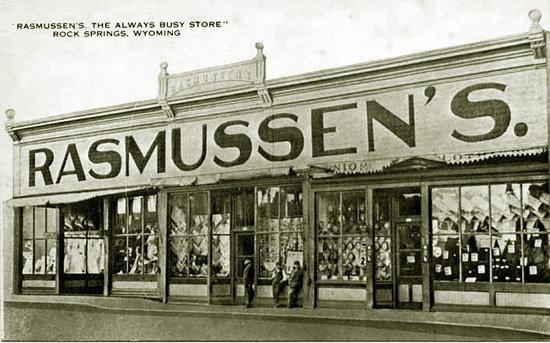
O. D. Rasmussen's Store, undated.

Wyoming General Hospital (the "Miners' Hospital"), Rock Springs, 1908
Upon admission to the Union on July 10, 1890,
the State received, among others, a 30,000 acre land grant to be used for the
construction and operations of the Miners' Hospital. In the 1892 election
Rock Springs was designated as the location. The cornerstone was laid on December
2, 1893, by members of Rock Springs Lodge Lodge No. 12, A.F. & A.M.
History of Masonry and other fraternal orders is discussed in
Cheyenne III as a part of text relating to fraternal lodges in
Cheyenne.
In 1901 the one-story nurses' dormitory was added. Two story additions were added
to the main structure in 1932 and 1940. The Hospital was transferred to Sweetwater
County in 1948. The Hospital now known as Memorial Hospital was moved to
its current location on College Drive in 1973.
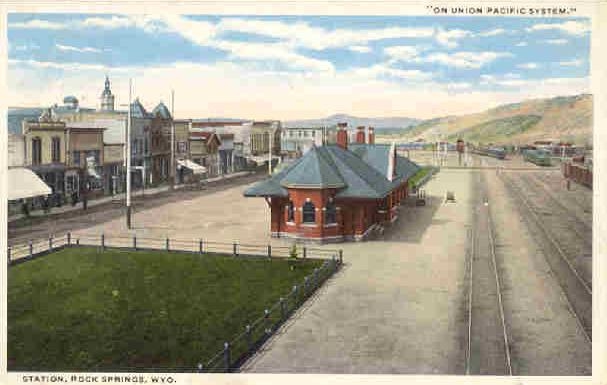
Rock Springs Depot, 1922
Compare above scene with earlier view above. The spire is the 1894 City Hall now housing
the Rock Springs Museum.
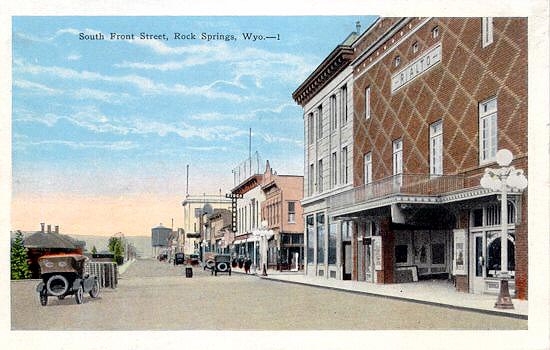
South Front Street, 1920's
The Rialto Theatre on the right side of the street was constructed in 1920. The theatre could seat 1200 and initially
featured a mix of motion pictures and vaudville. Vaudville shows were generally on
Sunday. Before the coming of talkies, the movies were accompanied by John Brueggemann's Rialto
Orchestra. The theatre was a principal venue for local community events. Other theatres included the
Grand and the Rex. The manager of the Rialto Amusement Company's operation in Rock Springs was Thomas Berta, noted for his
community efforts and the parties in his apartment in the Realto Theatre Building. The projector from
the Realto was moved to the Sweetwater County Historical Museum in 2005.
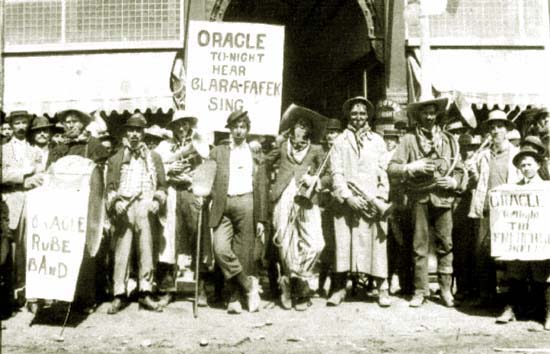
Rube Band in front of Oracle Theatre, undated.
In the 1920's Rock Springs even though it had a population
of over 9,000, paved streets, street lights, and a movie palace, did not leave much of an impression on some visitors. James Montgomery
Flagg, described his honeymoon stay:
Freight engines screamed and tooted around the little hotel at Rock Springs all night long,
as if warning the guests not to come out onto the tracks in their pyjamas.
I found out why Maclyn Arbuckle said, after a night in one of this town's
few hostelries, that he had discovered why it was called Rock Springs!
Writer's note: My bride's remembrance of Rock Springs is her
first trip to Wyoming, a rather "bumpy" ride, coming into Rock Springs on the "Vomit Comet." But, then, the
area around Rock Springs is noted for its down drafts and gusty winds which generate bumpy airplane
rides.
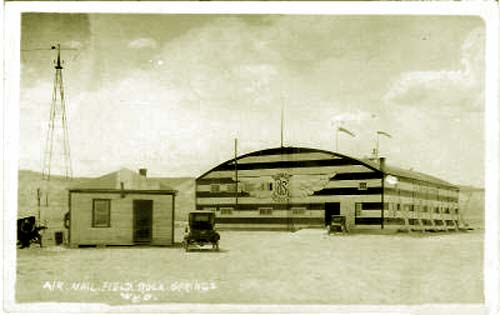
Rock Springs Airmail Station, 1920's
Airmail service through Rock Springs began in 1920 as part of the transcontinental route from Chicago to
California. During the first several years there were a number of forced landings and crashes. H. A. Collison, as an example,
twice crashed his plane on takeoff from Rock springs. Walter Bunting was killed shortly after takeoff. Lester Bishop had a forced landing
near Lyman in the winter and wandered ten miles through waist-deep snow before he was rescued by fellow pilot, Robert H. "Bob" Ellis.
Ellis, himself had a harrowing escape when a strong downdraft crashed his machine into the side of
White Mountain just west of Rock Springs. Undaunted, he rolled the sacks of mail down the mountain to be taken back to the
field. Mechanics scaled the mountain, dismantled the machine, carried the pieces back to the airfield and
reassembled the plane which was then put back into service. In 1925, Omaha newspapers reported that Ellis had gone blind. He had not and
continued with the service until the service was privatized in 1927, having flown more that 347,500 hours carrying the mails. For more on
early airmail service in Wyoming see Cheyenne Transcontinental Airport.
Next page, Rock Springs continued.
|